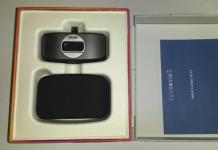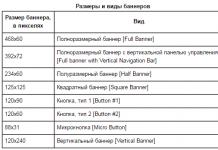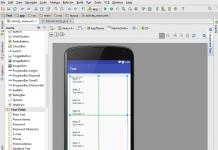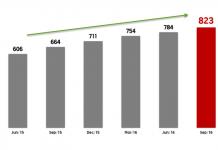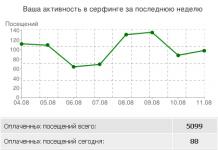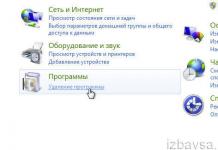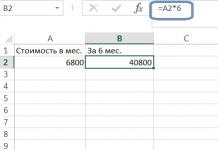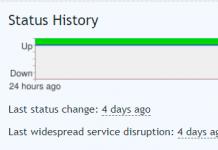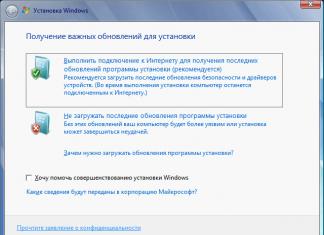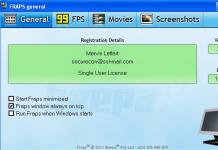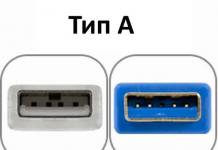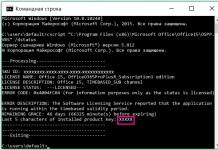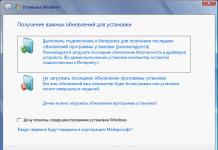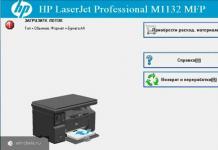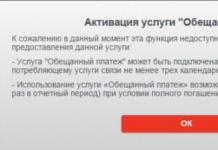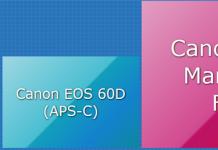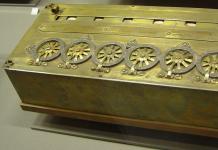It's been a year since I abandoned the DVD drive, and netbook trends indicate that I made the right decision. But I was faced with the question of how to install an operating system without a DVD. The flash drive died out of place, and when I went to the store to buy a new one, I accidentally caught my eye on the Seagate Expansion external drives, the 250Gb version of which cost literally 500 rubles more than the 8Gb flash drive (2323 rubles). And the size and all of which did not bother the jacket pocket much.
Dimensions:141 x 18 x 80 mm
Weight:0.16kg
But as it turned out, installing Windows 7 from a USB HDD does not work on the same principle as with USB FLASH. Having figured it out and checked its functionality, I’m sharing the information with you.
Works for both Desktop PCs, laptops and Netbooks.
- HDD preparation
- Cutting and preparing HDD partitions;
- Copying Windows 7
HDD preparation
You can make a boot disk, install Windows 7, and then erase it and continue to use the HDD for your needs. Or make it much more convenient:If you don’t mind 4 gigabytes of space on the External HDD, then the Disk can be cut into two parts, in our case I did just that, giving one part for the Windows 7 distribution kit, which will always be at hand.
Cutting and preparing HDD partitions
1. Go to:Control Panel - Administration - Computer Management (Disk Management)
Find Disk 1 (if you have several hard drives in your system, find the one that is equal to the size of your External HDD)
2. Select our External HDD drive:
- Right click with the mouse - Delete volume;
- Right click - Create simple volume;
In the window that appears, select the volume size of 4300 Megabytes (Under the Distribution section), and click next,
In the next dialog, if necessary, select the drive letter and click next. In the new dialog, you need to format our new partition (FAT 32), click next and you're done.
After this, you need to make the created section active, for this:
- right click on a section - make the section active.
Now our External HDD looks like this:
Using the same principle, we format the second partition on the disk, preferably in NTFS. but don't make it active.
Copying Windows 7
Copying a Windows distribution to a boot disk has never been easier.If you have DVD:
- Simply open your installation DVD, select all folders and files, and copy to the active partition of your External HDD;
If you have an ISO image:
- Simply open your installation ISO image through Total Commander or Daemon Tools, select all folders and files, and copy to the active partition of your External HDD;
That's it, your External HDD is ready to act as a Bootable media, just reboot, and in the BIOS Set it as Primary Boot Device. a specific External HDD, or just a USB HDD, depending on the BIOS type. Save the changes and proceed to installing your Windows 7.
UPD: For cmd lovers(Thank you )
diskpart
List disk
select disk no.
create partition primary
select partition 1
active
format fs=fat32 quick
Greetings, blog readers.
Today I would like to tell you why and how to install Windows on an external hard drive. This may be needed when users want to evaluate a new version of the operating system. Or they need a shell in which certain applications will run. Depending on the needs, the method also changes. Next we will look at the main points regarding this topic.
Placing Windows 10 on an external hard drive involves quite a few steps. First of all, you need to prepare the device itself. So, to get a removable hard drive with an OS, do the following:
Now we see an unallocated area of 60 GB, which will be needed to install Windows 8 or a newer version. Now we need to transform the space into one that will be “normally” perceived by the system:

As a result, a formatted partition with the NTFS file system will appear on the USB drive. This is where we will install the OS, be it Windows XP or newer versions.
WinNT Setup3 program( )
After we have prepared everything, we can proceed directly to placing the operating system on a removable device:
It’s worth noting right away that such an operation cannot be performed from a floppy drive to an external USB hard drive. This is due to many aspects. So, to get started, just prepare a virtual image.
Installing Win on an external HDD for Mac( )

Sometimes there are situations when users, for some reason, need to install a Microsoft operating system on a USB drive connected to a Mac computer. This could be a lack of highly specialized software options. Or simple interest. In any case, there is a way:
Let's launch our Mac. We check the system for viruses AVG AntiVirus Free. Download drivers for Boot Camp(a program that allows you to carry out the entire operation). To do this, go to “Programs” and then to “Utilities” or “Utilities” - this depends on the version of OS X.
We launch the application and indicate that we need to download everything to support Win.
Afterwards we will perform the actions through, which means the program needs to be downloaded and installed.

Let's launch. Select " Car" and "Create". A wizard for setting up a new “ virtual machines" Click " Continue».
Enter the name of the desired operating system, for example, Windows 7. The type will install itself. We continue until we reach the desired goal. At the very end, select “ Create».
Let's stop at "". Click on the disk next to " Drive: Secondary…».
We indicate the image from our OS.
We confirm the actions and start.
The Win installation screen will appear.

When “” appears, go to “ Devices" and then to "".

After completing the procedure, restart the computer.
Let's go to " Start», « Computer" On the sidebar we find “ Net" We open access to documents. The network should appear " VBOXSVR" Go in and copy the above directory to “”.

Then we go to " Control Panel" And " Programs" You need to find and remove " Oracle VM VirtualBox…" We restart the machine.
Let's go to the catalog " WindowsSupport" Launch " Setup.exe" After finishing, turn off " virtual».
We need in " Macintosh HD" Then in " Users" and to the directory " client_name" Further in "" and in " Windows 7».
We launch the main file with the extension *.vdi. The image is mounted.
Two new disks will appear among the devices. We copy all the contents from them to a new directory.

Connect and clean the USB-HDD. And you can’t do without formatting here.
Let's go to " Start" And " Computer" Then in " Home on psf" And "". We go to the previously created directory and transfer all the elements to our portable device.
It's been a year since I abandoned the DVD drive, and netbook trends indicate that I made the right decision. But I was faced with the question of how to install an operating system without a DVD. The flash drive died out of place, and when I went to the store to buy a new one, I accidentally caught my eye on the Seagate Expansion external drives, the 250Gb version of which cost literally 500 rubles more than the 8Gb flash drive (2323 rubles). And the size and all of which did not bother the jacket pocket much.
Dimensions:141 x 18 x 80 mm
Weight:0.16kg
But as it turned out, installing Windows 7 from a USB HDD does not work on the same principle as with USB FLASH. Having figured it out and checked its functionality, I’m sharing the information with you.
Works for both Desktop PCs, laptops and Netbooks.
- HDD preparation
- Cutting and preparing HDD partitions;
- Copying Windows 7
HDD preparation
You can make a boot disk, install Windows 7, and then erase it and continue to use the HDD for your needs. Or make it much more convenient:If you don’t mind 4 gigabytes of space on the External HDD, then the Disk can be cut into two parts, in our case I did just that, giving one part for the Windows 7 distribution kit, which will always be at hand.
Cutting and preparing HDD partitions
1. Go to:Control Panel - Administration - Computer Management (Disk Management)
Find Disk 1 (if you have several hard drives in your system, find the one that is equal to the size of your External HDD)
2. Select our External HDD drive:
- Right click with the mouse - Delete volume;
- Right click - Create simple volume;
In the window that appears, select the volume size of 4300 Megabytes (Under the Distribution section), and click next,
In the next dialog, if necessary, select the drive letter and click next. In the new dialog, you need to format our new partition (FAT 32), click next and you're done.
After this, you need to make the created section active, for this:
- right click on a section - make the section active.
Now our External HDD looks like this:
Using the same principle, we format the second partition on the disk, preferably in NTFS. but don't make it active.
Copying Windows 7
Copying a Windows distribution to a boot disk has never been easier.If you have DVD:
- Simply open your installation DVD, select all folders and files, and copy to the active partition of your External HDD;
If you have an ISO image:
- Simply open your installation ISO image through Total Commander or Daemon Tools, select all folders and files, and copy to the active partition of your External HDD;
That's it, your External HDD is ready to act as a Bootable media, just reboot, and in the BIOS Set it as Primary Boot Device. a specific External HDD, or just a USB HDD, depending on the BIOS type. Save the changes and proceed to installing your Windows 7.
UPD: For cmd lovers(thanks theproof)
diskpart
List disk
select disk no.
create partition primary
select partition 1
active
format fs=fat32 quick
Many of you, dear readers of the “Computer Smart” website, have probably already thought more than once about the question: is it possible to install Windows on an external usb hdd hard drive? And most importantly - why is this necessary? This may be needed at least as an alternative to Linux. After all, in its environment there have long been so-called “live” disks (LiveCD), which make it possible to run a full-fledged operating system with all its capabilities from an external USB or DVD media. Such a portable system allows you not only to revive a “fallen” OS (operating system) on the main computer, but also to work fully. So why not try installing windows on a usb drive and use it in the same way?
Difficulties with usually installing windows on an external usb hard drive
But, if Linux can be installed on any device, even an external one, without much difficulty, then this will not work with Windows. Therefore, in the process of implementing the plan, difficulties will naturally arise, namely:
- Windows 7 will honestly warn you that it is impossible to boot from USB, and it won’t even want to install it on it.
- The Windows installer does not know how to cooperate with VHD (Virtual Hard Disk, or translated into Russian - virtual hard disk).
- When booting Windows 7 from an external hard drive, a blue screen BSOD error occurs.
An alternative way to install windows on an external usb hard drive
As it turned out, enthusiasts have long found a way out of this situation. However, one obvious obstacle remains - the relatively low speed of working with an external hard drive. This is due to the low bandwidth of the USB bus. The use of widely used flash drives is allowed, but their operating speed is much slower compared to a hard drive, especially in constant read-write mode. Also note that this type of operation was not provided in Windows 7. So it is impossible to give a complete guarantee that you will be able to boot from a USB drive on various personal computers.
In general, we will need:
- An external USB hard drive (in our case with already created partitions), or a flash drive with a capacity of at least 8 GB.
- A virtual machine, such as VMWare Player.
- Versions of Windows 7 Ultimate or Enterprise, since they support the Native VHD boot feature, as well as the PWBoot utility, which will help us do all the “dirty” work, namely, set up the correct installation and operation of Windows on a USB drive.
Although you can use other versions of the OS. But in this case, you should first install the operating system on a physical disk, and not on a virtual one. With this option, simply skip the console manipulations during installation.
The process of installing windows on an external hard drive
Let's take a closer look at the whole process. First of all, from the installation disk or its image, you need to rewrite the install.wim file located in the sources directory to your physical hard drive. This is where all the OS files are located. By the way, the standard ImageX utility from the windows AIK package works well with wim images.
The utility will unpack the OS image directly to external media, that is, install Windows on a USB drive. It will come out much faster this way. The only negative here is that during the first boot you will need to go through the standard Windows initial setup procedure:
- selecting language options;
- time zone indication;
- creating a user, etc.
Agree that this is a small price to pay for future speed of work.
Naturally, you need to run PWBoot with administrator rights. When you first start, you will be offered a choice: installing a clean OS on a USB drive, or updating an existing system. Working with the program is not particularly difficult, but there are still a few nuances.
First, PWBoot does not understand the Cyrillic alphabet. If your Windows 7 installation image supports the installation of not one, but several OS editions, then you will need to choose one. How it's done? To do this, you can use the previously mentioned ImageX utility (the link to it was given above), running it with the info parameter and specifying the path to the wim file:
In the command output you need to find the Image Index item. Immediately after it there will be a description of the versions. In PWBoot, in the list for selecting the OS, the versions are arranged in the same order as in the command output (highlighted by frames in the picture below).

Secondly, you are offered two different installation options to choose from: directly to an external hard drive, and formatting is required, or to a virtual disk in VHD format. The second option with VHD is much more interesting. In practice, there will be only one file on the hard drive, inside which your virtual windows system will run and all your work will be done. The operating system loaded from the virtual disk will see your physical disk too. By the way, the speed of the system inside a virtual machine is almost the same as when working directly from the drive.
There are many benefits to using VHD. This format is understood by any program for creating virtual machines. In addition, its support is built directly into Windows 7 itself. This makes it possible to create, edit and mount VHD disks using standard Windows OS tools. This leads to some advantages, namely:
- the ability to simultaneously have several Windows installations on one logical volume;
- convenient and quick deployment of the operating system simultaneously on several PCs (personal computers);
- ease of rolling back changes in the system, etc.
Or vice versa, you can place the installed Windows 7 inside a VHD container.
But let's return to PWBoot. So, we indicate that we will install windows on the VHD:
Next, we will need to indicate the location of the future VHD container and give it a name. Naturally, it should be located on an external USB drive. A flash drive or external hard drive must be reformatted to the NTFS file system (FAT 32 is not suitable due to its restrictions on the maximum file size of 2 GB). Don't forget to make sure there is enough free space. Then the program will offer to create a disk with a minimum capacity. But it’s better to allocate as much space as may be needed for installed programs, documents, and everything else. A virtual disk can be made dynamic, that is, expandable as it is filled with files, by checking the appropriate box. This means that physically it will take up only as much space as the information it contains. Naturally, you can enable this option in order to save space on your physical hard drive. True, in this case the performance decreases somewhat.
Next, all that remains is to select the disk on which the bootloader will be installed (external USB hard drive or other drive), enable the Update bootcode and Add boot entry to BCD options, change the description of the boot menu item if desired, and click Install. The program will perform all subsequent steps for installing Windows on an external usb hdd independently. Usually the whole process takes no more than 10 minutes. Although this also depends on the speed of the selected USB drive.
Completing the installation
- disable optional services;
- remove components that you can do without;
- disable hard drive indexing.
It is also advisable to refrain from any operations that may place a significant load on the drive. It is also recommended to periodically defragment the external drive by connecting it to another system. Another, as yet unresolved problem is the organization of the paging file. Of course, you can use the DiskMod driver, which allows you to create a swap file directly on a USB drive, or you can not create it at all. But it’s still better to specify its location manually on the physical hard drive of the PC on which you will use portable Windows 7.
In the picture above you see a picture in which Disk C is actually just an HD container physically located on disk E.
kompum.ru
How to install windows on an external hard drive? Step-by-step instruction
Greetings, blog readers.
Today I would like to tell you why and how to install Windows on an external hard drive. This may be needed when users want to evaluate a new version of the operating system. Or they need a shell in which certain applications will run. Depending on the needs, the method also changes. Next we will look at the main points regarding this topic.
Installation process(to contents)
Placing Windows 10 on an external hard drive involves performing a considerable number of steps. First of all, you need to prepare the device itself. So, to get a removable hard drive with an OS, do the following:

Now we see an unallocated area of 60 GB, which will be needed to install Windows 8 or a newer version. Now we need to transform the space into one that will be “normally” perceived by the system:

As a result, a formatted partition with the NTFS file system will appear on the USB drive. This is where we will install the OS, be it Windows XP or more recent versions.
WinNT Setup3 program (to contents)
After we have prepared everything, we can proceed directly to placing the operating system on a removable device:

It’s worth noting right away that such an operation cannot be performed from a floppy drive to an external USB hard drive. This is due to many aspects. So, to get started, just prepare a virtual image.
Installing Win on an external HDD for Mac (to contents)

Sometimes there are situations when users, for some reason, need to install a Microsoft operating system on a USB drive connected to a Mac computer. This could be a lack of highly specialized software options. Or simple interest. In any case, there is a way:

The instructions are not the easiest. Therefore, if something is not clear, you can find out all the details from the video:
I hope you can achieve the desired result.
windwix.ru
Using an external hard drive to install windows
 We have already looked at the question of how to install Windows without a disk or flash drive. However, if you have an external HDD, you can use it to install the operating system. You don’t need any additional software – just built-in tools and knowledge of how to install Windows on an external hard drive are enough.
We have already looked at the question of how to install Windows without a disk or flash drive. However, if you have an external HDD, you can use it to install the operating system. You don’t need any additional software – just built-in tools and knowledge of how to install Windows on an external hard drive are enough.
Preparing an external drive
All settings are made using standard Windows tools without the use of additional software.
The procedure will be as follows:
- Connect the external hard drive to the computer using the USB interface.
- Right-click on the “Computer” shortcut and select the “Management” section. From the menu on the left, go to the Disk Management page.
- Find the connected external HDD. Be careful - if you select the wrong disk, you can destroy important data from system partitions.
- Delete the existing hard drive partitions by right-clicking on them one by one and selecting “Delete volume”. As a result, the entire volume of the disk must be unallocated area.
The next step is to create a new partition on your hard drive for recording the distribution:
- Right-click on the unallocated area and select “Create simple volume”.
- Specify the partition size in megabytes.
- Select a drive letter.
- Format the partition using the FAT32 file system, which is used on most flash drives.
The last step is to assign the section active status. This must be done, since the computer will boot from it. Right-click on the created volume and select “Make partition active.” 
How to make a section active
Users often encounter this kind of problem: when they try to make one of the created sections active, they cannot click on the corresponding button in the context menu, since the function is not available.
There are two solutions to this problem:
- Use methods for creating a bootable drive that work if you need to install windows from a flash drive. This can be using the command line or special utilities like Rufus, where installation media is created in two clicks.
- Launch the Diskpart utility and use it to make the partition active.
It’s faster and more convenient to immediately resort to the second method:
- Connect the external drive to your computer.
- Launch an elevated command prompt.
- Type the command “diskpart” and press Enter to launch the utility of the same name.
- Display a list of connected drives by typing “list disk”.
- Select the drive you want to work with. By default, number “0” is the disk on which the system is installed. This means that the connected external drive is selected with the “select disk 1” command.
- Find the partitions of the selected disk - “list partition”.
- Select the partition that you want to make the main one – “select partition 1”.
- Make the selected partition active using the "active" command.
After exiting the Diskpart utility using the “exit” command, you can begin transferring the distribution files to external media.
Copying distribution files
The copying order depends on the form of Windows distribution you have on hand. If this is a bootable DVD, then simply insert it into the drive and copy all the files through Explorer to the active partition of the external hard drive.
If you downloaded an ISO image to your computer, then to open it you will need special software - Total Commander, Daemon Tools or any archiver. Mount the image and open it through Windows Explorer, then transfer all the files to the external HDD.
Your hard drive can now act as bootable media. True, to start installing Windows, you still need to properly configure the BIOS by setting the boot priority on the “Boot” tab so that the data is read from the USB HDD first. 
After completing these simple steps, the standard Windows installation will begin, well known to all users.
mysettings.ru
Installing windows 7 on a USB drive
We remind you that attempts to repeat the author’s actions may lead to loss of warranty on the equipment and even to its failure. The material is provided for informational purposes only. If you are going to reproduce the steps described below, we strongly advise you to carefully read the article to the end at least once. The editors of 3DNews do not bear any responsibility for any possible consequences.
We have already looked at creating a Live CD or USB drive with Windows 7 and other software sets. This option is suitable for resuscitating an already installed OS, performing all sorts of service tasks (disk partitioning, cleaning viruses, etc.) and simply for quickly organizing a workplace. But these methods are not suitable for creating a full-fledged portable working environment. You can, of course, use a virtual machine - work inside a VM in the office or at home, and carry its image on a flash drive or external hard drive. This approach is obviously inconvenient because performance suffers, as well as the need to have an already installed OS and virtual machine on all PCs with which you have to work. Another option involves using cloud synchronization services like Dropbox, but this is not very suitable for transferring installed software.
Last year, one of my colleagues in correspondence asked about the possibility of using the most obvious, as it seems at first glance, method. Namely, installing windows directly on a hard drive with a USB interface or some fast flash drive. Indeed, in the Linux world this is a completely common occurrence (another colleague has been carrying around a protected external HDD with Ubuntu on board for a long time), so why not do the same with Windows? Without going into technical details, we’ll say right away that Windows 7 itself is not trained to do this trick (except for the Embedded version).
But enthusiasts have long come up with a ready-made solution to get around this little misunderstanding. There remains, however, one more obvious problem - the relatively low speed of working with an external drive, which will be limited by the bandwidth of the USB bus. Of course, USB 3.0 looks much more attractive in this regard, but not all PCs are equipped with these ports. The use of flash drives is acceptable, but they are usually much slower than HDDs under constant read-write conditions. Don't forget to also make sure that the machine you'll be working on supports booting from USB drives. Please note that this operating mode is not provided in Windows 7, so there is no guarantee that you will be able to boot from a USB drive on different computers.

So let's get started. We will need an external hard drive or flash drive with a minimum capacity of 8 GB, a Windows 7 installation disk (Windows 8 is also supported) or its image, as well as the wonderful PWBoot utility, which will do all the “dirty” work for us. From the installation disk, you need to copy the install.wim file, which is located in the sources directory, to any convenient location. It contains all the Windows files. In general, you can work with wim images using the ImageX utility from the windows AIK package.

During operation, the utility deploys the OS image (in fact, it stupidly unpacks the archive) directly to a removable drive. This will turn out much faster, but upon first boot you will have to carry out the standard system setup procedure: select language settings, time zone, create users, and so on. And this is a very small price to pay for speed.
When you launch PWBoot (with administrator rights, of course), you will be prompted to either install a clean OS on a USB drive, or patch an already installed system if you are somehow going to transfer it to an external drive. You will also have to “roll” the patch after installing service packs and, possibly, some windows updates. Working with the program is incredibly simple, so there’s almost nothing to tell. Nevertheless, there are still a couple of nuances.

Firstly, PWBoot stubbornly refuses to work with Cyrillic. If your Windows 7 installation image supports the installation of several OS editions at once, then you need to select the one you need. How to do it? Using the ImageX utility (see above), launched with the info parameter and specifying the path to the wim file.
imagex /info x:\path\to\install.wim
In the command output, look for the Image Index item and the version description that follows it. In PWBoot, the versions appear in the selection list in the same order as they appear in the command output.

Secondly, there are two installation options to choose from - directly to an external drive (with its mandatory formatting) or to a virtual disk in VHD format. The second option is much more interesting, but, unlike the first, it definitely requires Windows 7 Ultimate or Enterprise. More precisely, these editions support booting from VHD. In fact, there will be only one file on the disk in which all your work will take place. At the same time, in the OS loaded from the VHD, the physical disk will also be visible. Interestingly, the speed of the system inside the VHD is almost the same as when working directly from the drive.

In general, using VHD provides a lot of advantages. Firstly, any self-respecting virtual machine can work with this format, and its support is built right into Windows 7. You can create, edit, mount VHD disks and work with difference images (in fact, diff for an entire disk) using standard tools. This gives rise to such opportunities as the presence of several Windows installations on one logical volume, easy rollback of changes in the system, convenience and speed of OS deployment on many PCs at once, and so on.

You can, on the contrary, place the already installed windows inside the VHD container. In general, we won’t go into too much detail, fortunately this “trick” has long been known, and there are many good instructions on the Internet for working with VHD in Windows 7 and Windows Server 2008 R2. And for convenient editing of the windows bootloader menu, we can recommend the BellaVista utility.

Let's return to PWBoot. At the next stage, you need to specify the location and name of the future VHD container. Naturally, it must be on an external USB drive. Please note that the disk must have an NTFS file system (FAT32 is not suitable due to file size restrictions) and sufficient free space. The program itself will offer to make a minimum disk size, but it is better to allocate as much as you need for software, documents and everything else. A VHD disk can be made dynamic (expandable) by checking the appropriate box. That is, physically it will occupy exactly as much information as it contains. In general, to save space, you can enable this option, but at the same time lose a little in performance.

All that remains is to select the disk where the bootloader will be installed (that is, an external USB drive), check the Update bootcode and Add boot entry to BCD checkboxes, change the description of the boot menu item if desired, and click Install. That's it, the program will perform further installation steps itself. This usually takes no more than ten minutes, but a lot depends on the speed of the USB drive itself.

After installation, it is advisable to lighten the system a little - remove unnecessary components, disable non-critical services, turn off hard drive indexing, and generally try to avoid any operations associated with a heavy load on the drive. It is also useful to defragment the external drive by connecting it to another system. The problem with the swap file also remains unresolved - you can use the DiskMod driver to create it on a USB drive, you can abandon it altogether, but it is better to manually set its location on the normal HDD of the machine on which our portable Windows 7 is running.

Volume C: is an HD container that is physically located on volume E:
Finally, it is worth mentioning an interesting development called VBoot. It is a bootloader based on GRUB, but with support for direct booting from VHDs. And it doesn’t have to be Windows. The site, for example, has ready-made Ubuntu builds. In general, it’s a ready-made and convenient solution, but, of course, it’s paid – from $79 per license. By the way, Windows 8 will have a built-in ability to transfer your entire work environment to a USB drive and boot directly from it. In the meantime, you will have to be content with the above method. Good luck with your installation!

If you notice an error, highlight it with the mouse and press CTRL+ENTER.
3dnews.ru
Installing windows on an external USB hard drive
Many users of the Windows operating system have wondered: is it possible to install it on removable media, including an external hard drive? There are several reasons for such a step, for example, an installed OS on removable media will allow you to easily restore the OS if it stops starting. For the Linux kernel, this issue has long been resolved, and few people do not know about such things as Live CDs, which allow you to check the hard drive for viruses before starting the installed OS, perform various operations with the hard drive (setting sizes, formatting, etc.) d.). However, Windows and an external USB hard drive were, until recently, incompatible concepts. Now this issue can already be resolved, but only by performing certain actions, because there is no special version of Windows for hard drives.
Difficulties installing windows on an external USB hard drive
If in Linux the installation problem is thoroughly solved and everything is done using standard tools without any difficulties, certain problems may arise with Windows:
- The OS will inform you that installation on removable media, as well as startup, cannot be carried out;
- Windows lacks support for virtual hard disks;
- When I try to start Windows from a removable drive, a BSoD (blue screen of death) error appears.
An unofficial way to install windows on a hard drive
Some experts independently decided to study and find possible solutions for such installation of Windows on removable media. It must be said right away that with such an installation, the read and write speeds will not be high due to the rather low bandwidth of the USB bus. But if you consider that this installation is necessary for solving certain problems, and not for full-fledged work, this drawback is not so significant.
It's been a year since I abandoned the DVD drive, and netbook trends indicate that I made the right decision. But I was faced with the question of how to install an operating system without a DVD. The flash drive died out of place, and when I went to the store to buy a new one, I accidentally caught my eye on the Seagate Expansion external drives, the 250Gb version of which cost literally 500 rubles more than the 8Gb flash drive (2323 rubles). And the size and all of which did not bother the jacket pocket much.
Dimensions:141 x 18 x 80 mm
Weight:0.16kg
But as it turned out, installing Windows 7 from a USB HDD does not work on the same principle as with
USB FLASH. Having figured it out and checked its functionality, I’m sharing the information with you.
Works for both Desktop PCs, laptops and Netbooks.
- HDD preparation
- Cutting and preparing HDD partitions;
- Copying Windows 7
HDD preparation
You can make a boot disk, install Windows 7, and then erase it and continue to use the HDD for your needs. Or make it much more convenient:If you don’t mind 4 gigabytes of space on the External HDD, then the Disk can be cut into two parts, in our case I did just that, giving one part for the Windows 7 distribution kit, which will always be at hand.
Cutting and preparing HDD partitions
1. Go to:Control Panel - Administration - Computer Management (Disk Management)
Find Disk 1 (if you have several hard drives in your system, find the one that is equal to the size of your External HDD)
2. Select our External HDD drive:
— Right click with the mouse — Delete volume;
- Right click - Create simple volume;
In the window that appears, select the volume size of 4300 Megabytes (Under the Distribution section), and click next,
In the next dialog, if necessary, select the drive letter and click next. In the new dialog, you need to format our new partition (FAT 32), click next and you're done.
After this, you need to make the created section active, for this:
— right click on a section — make the section active.
Now our External HDD looks like this:
Using the same principle, we format the second partition on the disk, preferably in NTFS. but don't make it active.
Copying Windows 7
Copying a Windows distribution to a boot disk has never been easier.If you have DVD:
— Just open your installation DVD, select all folders and files, and copy to the active partition of your External HDD;
If you have an ISO image:
- Simply open your installation ISO image via


